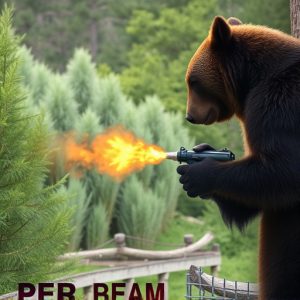Mastering Bear Spray Safety: Wind Direction Tips & Complementary Prevention
Bear spray, a powerful deterrent against bear attacks, utilizes capsaicin from chili peppers. Safe u…….
Bear spray, a powerful deterrent against bear attacks, utilizes capsaicin from chili peppers. Safe usage hinges on understanding wind direction and aiming away from oneself. Selection criteria include local bear behavior, wind patterns, and product effectiveness. Practice usage in controlled settings, keep it readily available, and learn quick deployment techniques for optimal safety. Additionally, hikers can minimize attack risks through prevention measures like staying alert, making noise, and using bear-resistant containers.
In regions inhabited by bears, knowing how to prevent and respond to attacks is crucial for outdoor enthusiasts. One effective tool in many survival kits: bear attack prevention spray. This article delves into the world of bear spray, offering insights on its composition, selection, application techniques, and safety tips, focusing on understanding wind direction as a critical factor in effectiveness. We also explore additional preventive measures to enhance safety in bear country.
- Understanding Bear Spray: What It Is and How It Works
- Choosing the Right Bear Spray for Your Needs
- Demonstrating Proper Usage Techniques
- Mastering Bear Spray Safety Tips: Wind Direction Matters
- Additional Prevention Measures to Complement Bear Spray
Understanding Bear Spray: What It Is and How It Works
Bear spray, also known as bear repellent, is a powerful tool designed to protect individuals from potential bear attacks in their natural habitat. This unique product contains capsaicin, the active ingredient found in chili peppers, which irritates a bear’s eyes and respiratory system. When sprayed towards an approaching bear, it temporarily disorients and discourages the animal, providing valuable time for escape or retreat.
Understanding the wind direction is crucial when carrying bear spray. It’s recommended to hold the can at an angle and aim away from yourself, as bears are likely to inhale the spray, making direct spraying on the bear effective. Safety tips include practicing with the spray before heading into bear country, ensuring it’s within reach during outdoor activities, and knowing how to deploy it quickly.
Choosing the Right Bear Spray for Your Needs
When selecting a bear spray, understanding your specific needs and the local environment is key. Different regions have varying bear species and behaviors, so consider factors like the average distance at which bears approach and their tendencies to be aggressive. Wind direction safety tips are crucial; you want a can that projects the spray effectively against the wind.
Choosing a product with an appropriate range (usually 20-30 feet) ensures it will work when needed. Check if the spray is designed for black bears, grizzly bears, or both, as formulations may differ to address unique behaviors and fur types. Always follow safety guidelines provided by manufacturers and practice using the spray in controlled settings to ensure its effectiveness and your comfort during an actual encounter.
Demonstrating Proper Usage Techniques
When using an outdoor bear attack prevention spray, demonstrating proper usage techniques is paramount to ensuring its effectiveness in critical moments. Always remember to aim for the face and eyes of the bear, as this area contains numerous sensory organs that can be temporarily disabled by the spray. Hold the canister upright, approximately 2-3 feet away from the target, and spray in a sweeping motion rather than a direct stream. This technique increases the likelihood of covering the bear’s eyes and nasal passage, creating safety.
Understanding the wind direction is another crucial safety tip when using bear spray. It’s recommended to spray into the wind or at an angle towards the prevailing breeze to avoid inhaling the chemicals yourself and to maximize the spray’s range. Be mindful that a strong headwind can blow the spray back towards you, so always keep your back to the wind when deploying it. Proper usage of bear spray, combined with knowledge of safety tips like wind direction, significantly enhances your chances of deterring an aggressive bear encounter successfully.
Mastering Bear Spray Safety Tips: Wind Direction Matters
When considering bear spray as a defense against potential attacks, understanding wind direction becomes a crucial aspect of safety. The effectiveness of bear spray relies heavily on proper application and timing. If used incorrectly, even in an encounter with a grizzly, it might not provide the desired protection.
In outdoor settings, where bears roam free, always be mindful of the wind’s current and potential shifts. Aiming and spraying bear spray requires you to face into the wind, ensuring that the chemicals move towards the bear rather than blowing back onto you. This simple step can significantly improve the chances of deterring an aggressive bear effectively.
Additional Prevention Measures to Complement Bear Spray
In addition to carrying bear spray, there are several prevention measures hikers and outdoor enthusiasts can take to minimize the risk of a bear attack. Understanding the wind direction is crucial; always keep bears in your peripheral vision and be aware of the space you occupy relative to potential shelter areas for bears. When setting up camp or stopping for a break, choose open spaces free from brush or dense vegetation, as this reduces hiding spots for bears.
Bear-resistant food storage containers are essential, especially when camping in bear country. Never leave food unattended, and store it securely to avoid attracting bears. Additionally, carrying noise makers like whistles can startle bears if they approach unexpectedly. Staying alert, making noise, and avoiding sudden movements can all help deter a potential attack.


